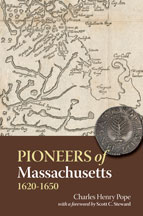 In his monumental work The Pioneers of Massachusetts, Charles Henry Pope summarized the occupations and trades of 1,725 of the 6,000 “pioneers” for whom the information was available. These 6,000 individuals were identified “in the journals and lists of the colonies, towns, churches and counties of the period 1620-1650, inclusive, as well as those perpetuated in the passenger-lists of that time which have survived to our day.” (Pope’s “day” was 1900, 115 years ago.)
In his monumental work The Pioneers of Massachusetts, Charles Henry Pope summarized the occupations and trades of 1,725 of the 6,000 “pioneers” for whom the information was available. These 6,000 individuals were identified “in the journals and lists of the colonies, towns, churches and counties of the period 1620-1650, inclusive, as well as those perpetuated in the passenger-lists of that time which have survived to our day.” (Pope’s “day” was 1900, 115 years ago.)
 Many of the occupations recorded by Pope are common today, while others are less so. I had to refer to a rootsweb list of colonial occupations to learn that practitioners of the eighth most frequent occupation (“Wearers, say-makers, websters”) appear to be weavers or loom operators, while “Felmongers” are workers who “remove … hair or wool from hides in preparation for leather making; a dealer in animal skins and hides, especially sheepskin.”
Many of the occupations recorded by Pope are common today, while others are less so. I had to refer to a rootsweb list of colonial occupations to learn that practitioners of the eighth most frequent occupation (“Wearers, say-makers, websters”) appear to be weavers or loom operators, while “Felmongers” are workers who “remove … hair or wool from hides in preparation for leather making; a dealer in animal skins and hides, especially sheepskin.”
There are some seeming anomalies: (75) “Mariners, sea Captains” but only (12) “Sailors,” (34) “Fishermen” and only (3) “Fishmongers,” (30) “Innholders, vintners, ordinary keepers” and only (6) “Brewers” and one lone “Distiller.”
My compatriots in the NEHGS Library will be shocked to learn that only one individual was identified as a “Bookseller,” and only one as a “Bookbinder.”
So, on this upcoming Labor Day, consider the occupations of your forebears. In my case, those include many, many farmers, a “chirurgeon” or two, and the ever-popular “ordinary keeper.”
(The entire text of The Pioneers of Massachusetts is also available in digital format at the Internet Archive. The list of occupations and trades is on p. 523.)
This is fascinating. If there is one thing that surely illuminates how a community lived, it’s the work the people there did. I like to think about how the people interacted as they went about their business, and how circumstances might have either shaped those occupations or over time changed them. One of my recent delights was reading a history of Simsbury/Grandby (CT) and coming across the names of my 5th great-grandparents. They were among those Simsbury people who joined the settlers at what became Grandby, and built there a sawmill. a “trip-hammer” shop (by which I presume that trip-hammers were made there), and a grist mill. Learning this suddenly brought Serajah and Eunice (Case) Stratton to full-blown life in my mind and gave me a sense of their place in the community. The book was “The Brittle Thread of Life”, by Mark Williams. It provided for me a citation which I will follow up on when I go to Connecticut to do research into original records, and hopefully to see the place these establishments once occupied. Soon, I hope.
These links may be of interest to you, Annie Stratton:
https://en.m.wikipedia.org/wiki/Trip_hammer
Whoops! Pressed Post inadvertently.
https://books.google.com/books?id=StQwAQAAMAAJ&pg=PA276&lpg=PA276&dq=trip-hammer+shop&source=bl&ots=0q77gtF1uX&sig=uoXS1hc_aqeD9jTH9vHLvWIrj9U&hl=en&sa=X&ved=0CCsQ6AEwBjgKahUKEwj0i8fthd7HAhUIGT4KHeb9B_I#v=onepage&q=trip-hammer%20shop&f=false
Interesting, thanks for the post and link to see the entire book.